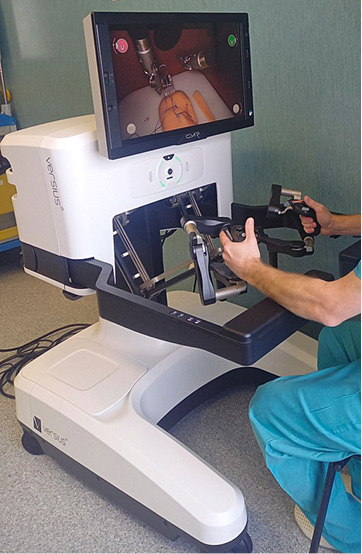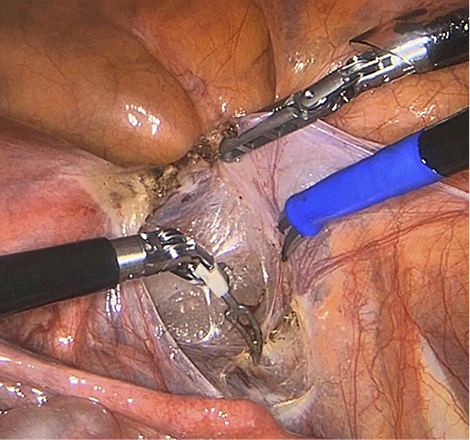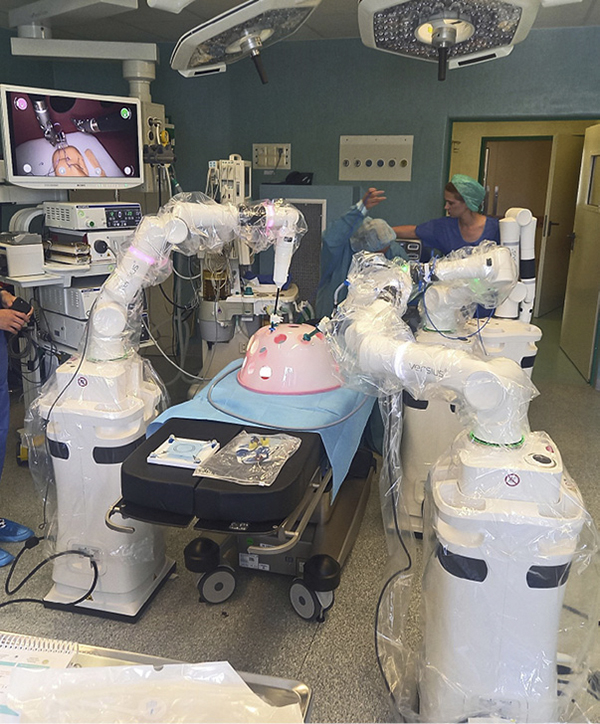Lietuvos chirurgija ISSN 1392–0995 eISSN 1648–9942
2023, vol. 22(3), pp. 144–150 DOI: https://doi.org/10.15388/LietChirur.2023.22(3).2
Multidisciplinary Implementation of the First VERSIUS Robotic Surgical System in the Baltic Countries
Marius Petrulionis
Vilnius University Hospital Santaros Klinikos, Vilnius, Lithuania
E-mail: marius.petrulionis@santa.lt
Ugne Silinskaite
Faculty of Medicine, Vilnius University, Vilnius, Lithuania
E-mail: ugnesilinskaite@gmail.com
Marius Kryzauskas
Vilnius University Hospital Santaros Klinikos, Vilnius, Lithuania
E-mail: marius.kryzauskas@santa.lt
Andrius Rybakovas
Vilnius University Hospital Santaros Klinikos, Vilnius, Lithuania
E-mail: andrius.rybakovas@santa.lt
Vilius Rudaitis
Vilnius University Hospital Santaros Klinikos, Vilnius, Lithuania
E-mail: vilius.rudaitis@santa.lt
Linas Andreika
Vilnius University Hospital Santaros Klinikos, Vilnius, Lithuania
E-mail: linas.andreika@santa.lt
Albertas Cekauskas
Vilnius University Hospital Santaros Klinikos, Vilnius, Lithuania
E-mail: albertas.cekauskas@santa.lt
Arnas Bakavicius
Vilnius University Hospital Santaros Klinikos, Vilnius, Lithuania
E-mail: arnas.bakavicius@santa.lt
Arunas Zelvys
Vilnius University Hospital Santaros Klinikos, Vilnius, Lithuania
E-mail: arunas.zelvys@santa.lt
Feliksas Jankevicius
Vilnius University Hospital Santaros Klinikos, Vilnius, Lithuania
E-mail: feliksas.jankevicius@santa.lt
Valdas Peceliunas
Vilnius University Hospital Santaros Klinikos, Vilnius, Lithuania
E-mail: valdas.peceliunas@santa.lt
Tomas Januskevicius
Vilnius University Hospital Santaros Klinikos, Vilnius, Lithuania
E-mail: tomas.januskevicius@santa.lt
Augustinas Matulevicius
Vilnius University Hospital Santaros Klinikos, Vilnius, Lithuania
E-mail: augustinas.matulevicius@santa.lt
Kestutis Strupas
Institute of Clinical Medicine, Faculty of Medicine, Vilnius University, Vilnius, Lithuania
Vilnius University Hospital Santaros Klinikos, Vilnius, Lithuania
E-mail: kestutis.strupas@santa.lt
Tomas Poskus
Institute of Clinical Medicine, Faculty of Medicine, Vilnius University, Vilnius, Lithuania
Vilnius University Hospital Santaros Klinikos, Vilnius, Lithuania
E-mail: tomas.poskus@santa.lt
Abstract. On June, 2023, Vilnius University Hospital Santaros Klinikos started robotic-assisted operations using VERSIUS robotic surgery system (CMR, Cambridge, UK) and performed 29 robotic surgeries within the first 3 weeks. This surgical system was purchased with funding from the European Regional Development Fund. Comprehensive three-month-long learning courses were organized for a total number of 32 persons, forming 8 independent teams, each consisting of 2 surgeons and 2 nurses. Learning courses consisted of online theoretical training modules, a one-week learning course including technical skills training with a simulator and dry runs as well as cadaveric surgical cases. Furthermore, an additional learning module included dry runs in the operating room prior to the first surgeries, following live and online proctored surgical cases. This enabled a rapid and smooth introduction of the robotic surgical system into clinical practice without putting patients at risk. Abdominal surgeons, urologists, and gynecologists have already performed surgeries using the VERSIUS surgical system and no major complications have been reported. Thoracic surgeons are underway to begin thoracic robotic-assisted surgeries, completing the multidisciplinary VERSIUS surgical system implementation process.
Our goal is to share initial experience with robotic VERSIUS surgical system and evaluate its implementation in Vilnius University Hospital Santaros Klinikos.
Key words: VERSIUS surgical system, robotic surgery, robotic-assisted surgery, general surgery, urology, obstetrics and gynaecology.
Pirmosios Baltijos šalyse taikomos robotinės chirurgijos sistemos „Versius“ daugiadisciplinis diegimas
Santrauka. 2023 m. birželio mėn. Vilniaus universiteto ligoninėje Santaros klinikose pradėtos atlikti robotinės operacijos, naudojant robotinės chirurgijos sistemą „Versius“ (CMR, Kembridžas, JK). Per pirmąsias tris savaites atliktos 29 robotinės operacijos. Sistema įsigyta panaudojus Europos regioninės plėtros fondo lėšas.
Išsamius 3 mėn. teorinius kursus išklausė ir praktiniuose mokymuose dalyvavo 32 Santaros klinikų medicinos darbuotojai. Jie suformavo 8 nepriklausomas komandas, sudarytas iš 2 chirurgų ir 2 slaugytojų. Mokymosi kursai apėmė: nuotolinius teorinio mokymo modulius; vienos savaitės mokymosi kursą, kurio metu lavinti techniniai įgūdžiai naudojant virtualiosios realybės simuliatorius; techninių įgūdžių mokymus, naudojant pilvo ertmės ir krūtinės ląstos ertmės operacijų muliažus; praktinius seminarus, per kuriuos buvo atliekamos operacijos, naudojant kadaverinius preparatus. Artėjant pirmosioms operacijoms, visos 8 komandos išėjo antrąjį mokymosi kursą operacinėje, naudodamiesi chirurginių įgūdžių lavinimo ir operacijų simuliavimo muliažais. Mokymų kursų pabaigoje atliktos kruopščiai suplanuotos pirmosios robotinės operacijos, dalyvaujant patyrusiems robotinės chirurgijos specialistams – mentoriams.
Kruopštus standartizuotas mokymosi procesas leido greitai ir sklandžiai įdiegti robotinę chirurgiją į klinikinę praktiką, nekeliant pavojaus pacientams. Naudodami chirurginę sistemą „Versius“, pilvo chirurgai, urologai ir ginekologai jau atliko reikšmingą kiekį operacijų, išvengdami didelių komplikacijų. Pastaruoju metu pirmąsias operacijas atliko ir krūtinės chirurgai. Taip Vilniaus universiteto ligoninėje Santaros klinikose baigiamas robotinės chirurgijos sistemos „Versius“ daugiadisciplinio diegimo procesas.
Straipsnio tikslas – pasidalyti pirmąja patirtimi, naudojant „Versius“ robotinės chirurgijos sistemą, ir įvertinti šios sistemos diegimo Vilniaus universiteto ligoninėje Santaros klinikose procesą.
Reikšminiai žodžiai: robotinės chirurgijos sistema „Versius“, robotinė chirurgija, bendroji chirurgija, urologija, akušerija ir ginekologija.
Received: 2023/08/30. Accepted: 2023/09/27.
Copyright © 2023 Marius Petrulionis, Ugne Silinskaite, Marius Kryzauskas, Andrius Rybakovas, Vilius Rudaitis, Linas Andreika, Albertas Cekauskas, Arnas Bakavicius, Arunas Zelvys, Feliksas Jankevicius, Valdas Peceliunas, Tomas Januskevicius, Augustinas Matulevicius, Kestutis Strupas, Tomas Poskus. Published by Vilnius University Press. This is an Open Access article distributed under the terms of the Creative Commons Attribution Licence, which permits unrestricted use, distribution, and reproduction in any medium, provided the original author and source are credited.
Introduction
Robotic-assisted surgery is currently one of the fastest developing fields of modern medicine. Robotic surgery systems are a complex of modern equipment, composed of integrated or multinodular robotic surgical manipulators and a console, allowing surgeons to perform minimally invasive operations from a distance. Worldwide, the very first robotic operation – a robotic-assisted cholecystectomy – was performed in 1997, Belgium, using “da Vinci®” surgical system, while in 2001 the first remote transatlantic robotic-assisted cholecystectomy was accomplished [1, 2]. In Lithuania, history of robotic surgery dates back to 2018 as robotic-assisted operations were implemented in Klaipeda University Hospital, with first 100 cases reported in 2020 [3].
On June 2023, Vilnius University Hospital Santaros Klinikos – one of the largest hospitals in the country – officially announced that it has acquired VERSIUS robotic surgical system (CMR, Cambridge, UK) and started performing robotic operations. VERSIUS surgical system was purchased with funding from the European Regional Development Fund. This system should not only improve outcomes of patients but is also more comfortable for the surgeons. It can be used while sitting or standing, allowing the surgeon to choose the most comfortable personal operating position and maintain excellent surgical performance.
Our goal is to share the initial experience with robotic VERSIUS surgical system and evaluate its implementation in Vilnius University Hospital Santaros Klinikos.
Material and Methods
VERSIUS robotic surgical system consists of a surgeon console (Fig. 1) and 4 bedside units (Fig. 2). Six different instruments, including a fenestrated grasper, a bipolar Maryland grasper, curved scissors, monopolar curved scissors (Fig. 3), a monopolar hook and a needle holder (Fig. 4), can be used when attached to the bedside units. The system is mobile and can be easily transported from one operating room to another [4, 5].
To ensure efficient implementation of VERSIUS robotic system, standardised training courses for surgeons and nurses were organized. They consisted of online theoretical training modules, a one-week learning course including technical skills training with simulator, and dry runs as well as cadaveric surgical cases. Furthermore, additional learning module included dry runs in the operating room prior to the first operations (Fig. 5), following live and online proctored surgical cases. A total number of 32 persons were trained within the period of 3 months to gain sufficient skills to use VERSIUS robotic system, forming 8 independent teams, each consisting of 2 surgeons and 2 nurses.

Figure 1. Surgeon’s console of VERSIUS robotic surgical system

Figure 2. Bed-side units of VERSIUS robotic surgical system

Figure 3. A fenestrated grasper, a bipolar Maryland grasper and monopolar curved scissors

Figure 4. Suturing with two robotic needle holders

Figure 5. Dry run surgery simulation in operation room – obligatory step of VERSIUS system training
Results
During the first 3 weeks of implementation process, 29 patients underwent robotic-assisted surgery. Abdominal surgeons performed 14 operations, including 2 right hemicolectomies, 8 cholecystectomies, 3 unilateral and 1 bilateral inguinal hernia repairs. Urologists used VERSIUS surgical system for 8 robotic-assisted prostatectomies, 1 robotic nephrectomy and 1 pyeloplasty. Gynaecologists performed 1 radical hysterectomy with pelvic lymphadenectomy, 1 subtotal hysterectomy, 1 cystectomy for endometrioid cysts and 2 cystectomies for ovarian cysts. All surgeries were without major complications and are considered a success. Subsequently, thoracic surgeons are underway to begin thoracic robotic-assisted surgeries, completing the multidisciplinary VERSIUS surgical system implementation at Vilnius University Hospital Santaros Klinikos.
Discussion
Robotic-assisted surgery is the major step of advancement in laparoscopic surgical approach. It has already shown benefits compared to conventional laparoscopy in certain fields of general and abdominal surgery including colorectal surgery and hernia surgery [6–8]. Furthermore, current guidelines of hepatopancreatobiliary (HPB) surgery recommend that certain operations including pancreatoduodenal resections for cancer should be performed in robotic-assisted rather than laparoscopic way, while left and distal robotic pancreas robotic resections are considered as non-inferior compared to laparoscopic approach [9, 10]. Radical prostatectomy is another field in which robotic surgery has shown a non-inferior of short and long term outcomes compared to laparoscopic approach [11, 12]. VERSIUS surgical system has shown some benefits in comparison to other commercially available robotic surgery systems, particularly – when performing surgery in small cavities [4].
Abdominal surgeons, urologists, and gynecologists in Vilnius University Hospital Santaros Klinikos have already performed surgeries with VERSIUS robotic surgical system, and no major complications have been reported, while thoracic surgeons are starting robotic operations to complete the multidisciplinary implementation process. The first weeks of our experience on VERSIUS surgical system implementation have shown good initial outcomes as a significant number of operations have been safely performed during the first weeks, what corresponds to the findings previously described by other groups [5, 13, 14].
Conclusion
During the first 3 weeks of implementation process, 29 patients underwent robotic-assisted surgery. All surgeries were without major complications and are considered a success. Standardized precise learning courses are essential for fast and smooth implementation of robotic VERIUS surgical system in clinical practice.
References
1. Lane T. A Short History of Robotic Surgery. Ann R Coll Surg Engl 2018; 100(6_sup): 5–7.
2. Marescaux J, Leroy J, Rubino F, Smith M, Vix M, Simone M, Mutter D. Transcontinental Robot-Assisted Remote Telesurgery: Feasibility and Potential Applications. Ann Surg 2002; 235(4): 487–492.
3. Samalavicius NE, Janusonis V, Siaulys R, Jasėnas M, Deduchovas O, Venckus R, Ezerskiene V, Paskeviciute R, Klimaviciute G. Robotic Surgery Using Senhance® Robotic Platform: Single Center Experience with First 100 Cases. J Robot Surg 2020; 14(2): 371–376.
4. Kayser M, Krebs TF, Alkatout I, Kayser T, Reischig K, Baastrup J, Meinzer A, Ulrich K, Osmonov D, Bergholz R. Evaluation of the Versius Robotic Surgical System for Procedures in Small Cavities. Children (Basel) 2022; 9(2): 199.
5. Haig F, Medeiros ACB, Chitty K, Slack M. Usability Assessment of Versius, a New Robot-Assisted Surgical Device for Use in Minimal Access Surgery. BMJ Surg Interv Health Technol 2020; 2(1): e000028.
6. Khan JS, Banerjee AK, Kim SH, Rockall TA, Jayne DG. Robotic Rectal Surgery Has Advantages Over Laparoscopic Surgery in Selected Patients and Centres. Colorectal Dis 2018; 20(10): 845–853.
7. Jayne D, Pigazzi A, Marshall H, Croft J, Corrigan N, Copeland J, Quirke P, West N, Rautio T, Thomassen N, Tilney H, Gudgeon M, Bianchi PP, Edlin R, Hulme C, Brown J. Effect of Robotic-Assisted vs Conventional Laparoscopic Surgery on Risk of Conversion to Open Laparotomy Among Patients Undergoing Resection for Rectal Cancer: The ROLARR Randomized Clinical Trial. JAMA 2017; 318(16): 1569–1580.
8. Lomanto D, Abatayo A, Maia RAB. Robotic Hernia Surgery: An Attractive Perspective. Asian J Endosc Surg 2017; 10(3): 233–235.
9. Asbun HJ, Moekotte AL, Vissers FL, Kunzler F, Cipriani F, Alseidi A, D’Angelica MI, Balduzzi A, Bassi C, Björnsson B, Boggi U, Callery MP, Del Chiaro M, Coimbra FJ, Conrad C, Cook A, Coppola A, Dervenis C, Dokmak S, Edil BH, Edwin B, Giulianotti PC, Han HS, Hansen PD, van der Heijde N, van Hilst J, Hester CA, Hogg ME, Jarufe N, Jeyarajah DR, Keck T, Kim SC, Khatkov IE, Kokudo N, Kooby DA, Korrel M, de Leon FJ, Lluis N, Lof S, Machado MA, Demartines N, Martinie JB, Merchant NB, Molenaar IQ, Moravek C, Mou YP, Nakamura M, Nealon WH, Palanivelu C, Pessaux P, Pitt HA, Polanco PM, Primrose JN, Rawashdeh A, Sanford DE, Senthilnathan P, Shrikhande SV, Stauffer JA, Takaori K, Talamonti MS, Tang CN, Vollmer CM, Wakabayashi G, Walsh RM, Wang SE, Zinner MJ, Wolfgang CL, Zureikat AH, Zwart MJ, Conlon KC, Kendrick ML, Zeh HJ, Hilal MA, Besselink MG; International Study Group on Minimally Invasive Pancreas Surgery (I-MIPS). The Miami International Evidence-based Guidelines on Minimally Invasive Pancreas Resection. Ann Surg 2020; 271(1): 1–14.
10. Abu Hilal M, van Ramshorst TME, Boggi U, Dokmak S, Edwin B, Keck T, Khatkov I, Ahmad J, Al Saati H, Alseidi A, Azagra JS, Björnsson B, Can FM, D’Hondt M, Efanov M, Alvarez FE, Esposito A, Ferrari G, Koerkamp BG, Gumbs AA, Hogg ME, Huscher CGS, Ielpo B, Ivanecz A, Jang JY, Liu R, Luyer MDP, Menon K, Nakamura M, Piardi T, Saint-Marc O, White S, Yoon YS, Zerbi A, Bassi C, Berrevoet F, Chan C, Coimbra FJ, Conlon KCP, Cook A, Dervenis C, Falconi M, Ferrari C, Frigerio I, Fusai GK, De Oliveira ML, Pinna AD, Primrose JN, Sauvanet A, Serrablo A, Smadi S, Badran A, Baychorov M, Bannone E, van Bodegraven EA, Emmen AMLH, Giani A, de Graaf N, van Hilst J, Jones LR, Sandri GBL, Pulvirenti A, Ramera M, Rashidian N, Sahakyan MA, Uijterwijk BA, Zampedri P, Zwart MJW, Alfieri S, Berti S, Butturini G, Di Benedetto F, Ettorre GM, Giuliante F, Jovine E, Memeo R, Portolani N, Ruzzenente A, Salvia R, Siriwardena AK, Besselink MG, Asbun HJ; Collaborators. The Brescia Internationally Validated European Guidelines on Minimally Invasive Pancreatic Surgery (EGUMIPS). Ann Surg 2023.
11. Yaxley JW, Coughlin GD, Chambers SK, Occhipinti S, Samaratunga H, Zajdlewicz L, Dunglison N, Carter R, Williams S, Payton DJ, Perry-Keene J, Lavin MF, Gardiner RA. Robot-Assisted Laparoscopic Prostatectomy versus Open Radical Retropubic Prostatectomy: Early Outcomes from a Randomised Controlled Phase 3 Study. Lancet 2016; 388(10049): 1057–1066.
12. Coughlin GD, Yaxley JW, Chambers SK, Occhipinti S, Samaratunga H, Zajdlewicz L, Teloken P, Dunglison N, Williams S, Lavin MF, Gardiner RA. Robot-Assisted Laparoscopic Prostatectomy versus Open Radical Retropubic Prostatectomy: 24-Month Outcomes from a Randomised Controlled Study. Lancet Oncol 2018; 19(8): 1051–1060.
13. Collins D, Paterson HM, Skipworth RJE, Speake D. Implementation of the Versius Robotic Surgical System for Colorectal Cancer Surgery: First Clinical Experience. Colorectal Dis 2021; 23(5): 1233–1238.
14. Dixon F, Qureshi A, Vitish-Sharma P, Khanna A, Keeler BD. Implementation of Robotic Hernia Surgery Using the Versius® System. J Robot Surg 2023; 17(2): 565–569.